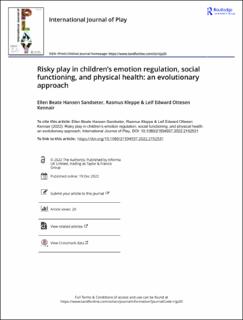Risky play in children’s emotion regulation, social functioning, and physical health: an evolutionary approach
Peer reviewed, Journal article
Published version
Permanent lenke
https://hdl.handle.net/11250/3039267Utgivelsesdato
2022-12-19Metadata
Vis full innførselSamlinger
- Artikler (Articles) [173]
- Publikasjoner fra Cristin - DMMH [138]
Sammendrag
The focus of this theoretical paper is to explore three biopsychosocial levels of children’s risky play: (1) mental health and emotion regulation, (2) social functioning and challenging norms, and (3) physical health and development. As such, in this paper, we expand Sandseter’s and Kennair’s focus in their original article in 2011 on the evolved function of risky play as an anti-phobic mechanism, and consider other types of risk than physical risks and other types of play, including other types of emotional regulation than anxiety reduction. Motivated by the thrilling emotions involved in risky play, one matures in competency and masters new and more complex psychosocial settings. Play with emotional, social, and physical risk may have evolved to increase the child’s psychosocial competency here-and-now, but also train them for future adult contexts. We recommend that future research consider how risky play in all contexts may have a similar function. Risky play in children’s emotion regulation, social functioning, and physical health: an evolutionary approach

